Intel NUC 13 Pro Arena Canyon Review: Raptor Lake Brings Incremental Gains
by Ganesh T S on March 27, 2023 9:00 AM ESTSystem Performance: UL and BAPCo Benchmarks
Our 2022 Q4 update to the test suite for Windows 11-based systems carries over some of the standard benchmarks we have been using over the last several years, including UL's PCMark. New additions include BAPCo's CrossMark multi-platform benchmarking tool, as well as UL's Procyon benchmark suite. BPACo recently updated their SYSmark benchmark suite - while operational at a basic level, it is missing key features such as energy consumption measurement. We will start including SYSmark 30 once the open issues are resolved.
UL PCMark 10
UL's PCMark 10 evaluates computing systems for various usage scenarios (generic / essential tasks such as web browsing and starting up applications, productivity tasks such as editing spreadsheets and documents, gaming, and digital content creation). We benchmarked select PCs with the PCMark 10 Extended profile and recorded the scores for various scenarios. These scores are heavily influenced by the CPU and GPU in the system, though the RAM and storage device also play a part. The power plan was set to Balanced for all the PCs while processing the PCMark 10 benchmark. The scores for each contributing component / use-case environment are also graphed below.
| UL PCMark 10 - Performance Scores | |||

The productivity workload sees the Ryzen 7-5800U system come out on top (thanks probably to the presence of 8 high performance cores), but that system loses steam in other components. The overall scores are along expected lines - the Intel RPL-P system is ahead of the ASRock Industrial RPL-P one, which in turn is a bit in front of the Alder Lake-P systems.
UL Procyon v2.1.544
PCMark 10 utilizes open-source software such as Libre Office and GIMP to evaluate system performance. However, many of their professional benchmark customers have been requesting evaluation with commonly-used commercial software such as Microsoft Office and Adobe applications. In order to serve their needs, UL introduced the Procyon benchmark in late 2020. There are five benchmark categories currently - Office Productivity, AI Inference, Battery Life, Photo Editing, and Video Editing. AI Inference benchmarks are available only for Android devices, while the battery life benchmark is applicable to Windows devices such as notebooks and tablets. We presents results from our processing of the other three benchmarks.
| UL Procyon - Office Productivity Scores | |||

With similar processors and RAM, the NUCS BOX-1360P/D4 and the NUC13ANKi7 perform very similarly across all four components, getting on top in two each. The recorded scores are within the margin of run to run variations.
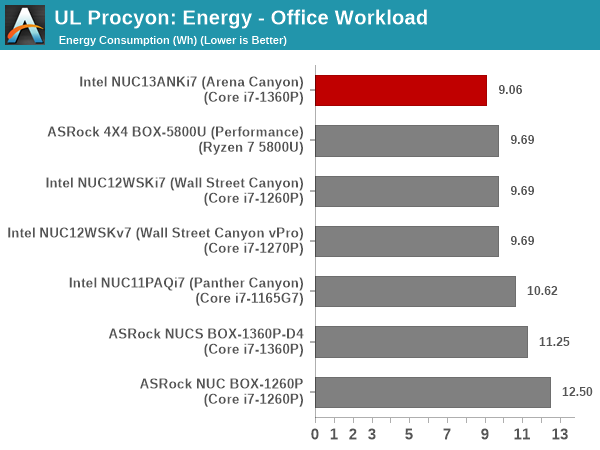
The Arena Canyon NUC forges ahead on the energy consumption front, though. In fact, the ASRock Industrial system comes way beind at 11.25 Wh compared to the Arena Canyon NUC's 9.06 Wh. These numbers can be due to different BIOS optimization targets.
Moving on to the evaluation of Adobe Photoshop and Adobe Lightroom, we find the Arena Canyon NUC come out comfortably on top, but it guzzles a lot more energy in the process compared to the 4x4 BOX-5800U.
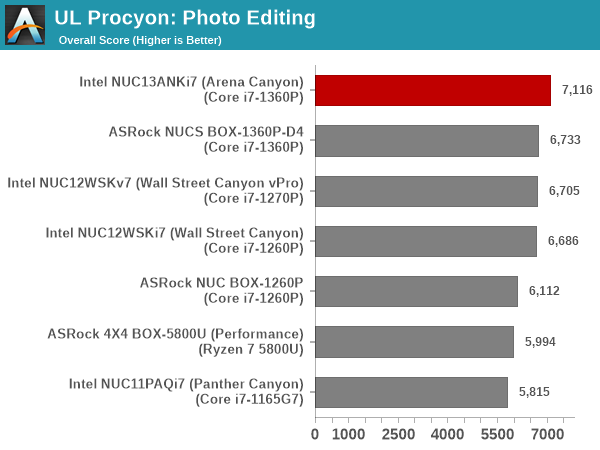
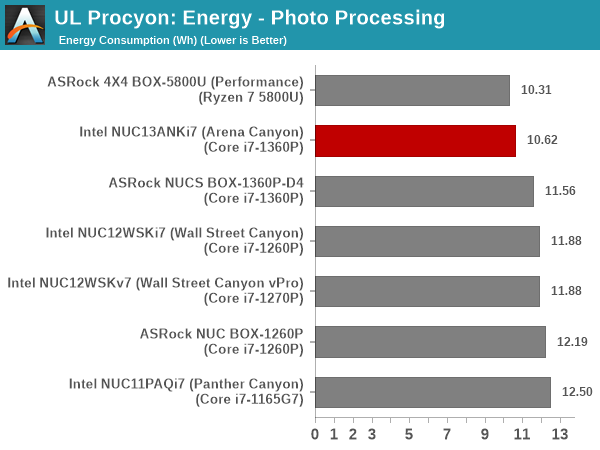
UL Procyon evaluates performance for video editing using Adobe Premier Pro, with the GPU playing a major role.
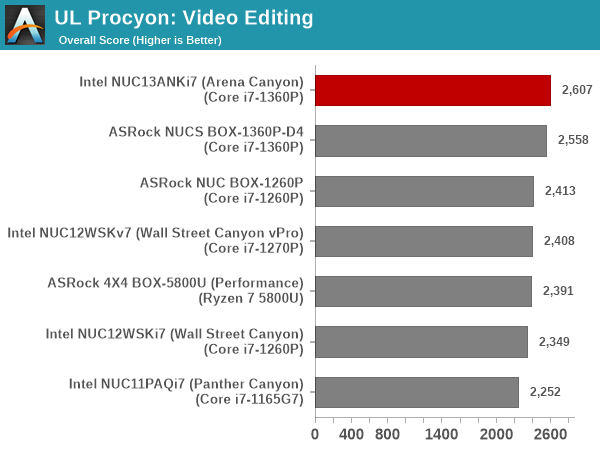
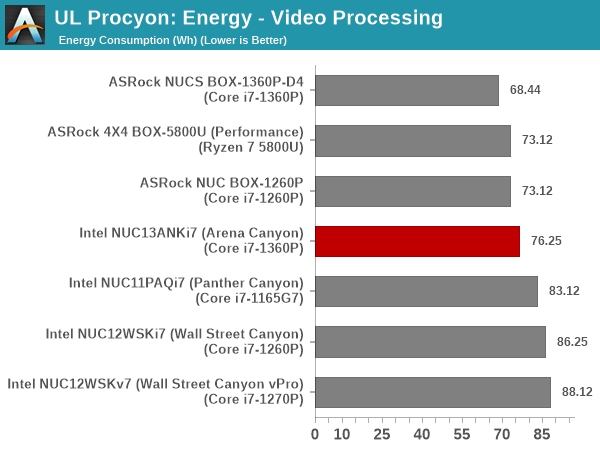
The aggressively clocked iGPU in the Core i7-1360P helps the Arena Canyon NUC and the NUCS BOX-1360P/D4 to deliver similar scores, with the former coming out on top. However, the energy consumption number is significantly higher despite the faster processing.
BAPCo CrossMark 1.0.1.86
BAPCo's CrossMark aims to simplify benchmark processing while still delivering scores that roughly tally with SYSmark. The main advantage is the cross-platform nature of the tool - allowing it to be run on smartphones and tablets as well.
| BAPCo CrossMark 1.0.1.86 - Sub-Category Scores | |||
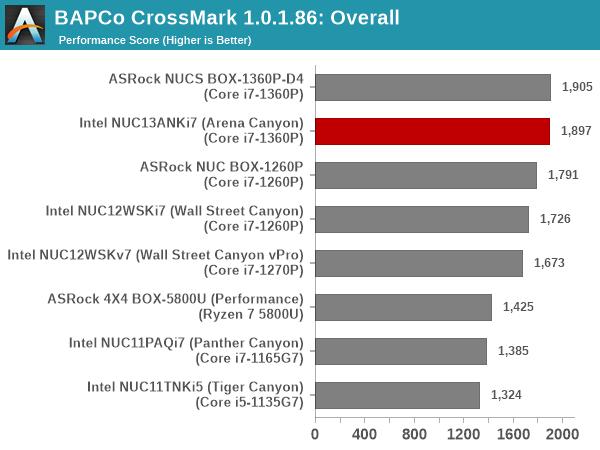
The relative performance seen in PCMark 10 translate to CrossMark also, as expected. The responsiveness ratings vary significantly due to differences in the default BIOS settings for options such as PCIe ASPM etc. We see the ASRock Industrial units emerge with high responsiveness ratings (ASPM disabled by default), while Arena Canyon opts to optimize for power efficiency by enabling ASPM. Overall, we see the Arena Canyon NUC score very similarly to the NUCS BOX-1360P/D4, and well ahead of the rest of the pack.










46 Comments
View All Comments
PeachNCream - Tuesday, March 28, 2023 - link
I congratulate you. Your bait caught a lot of them this time. And, like a true troll, you didn't waste keystrokes doing it. Though, admittedly, computer enthusiasts are low hanging fruit that get riled up with minimal work.MrCommunistGen - Monday, March 27, 2023 - link
I'm pretty pleased that there are P-series chips and not just U-series - as many (but not all) previous SFF NUCs used 15W TDP chips rather than 28W and higher TDP mobile CPUs. As long as the cooler can handle the heat load and isn't too terribly loud (or can have its performance/fan curves adjusted) then this could be a really cool SFF PC.I currently have a NUC8i7BEH i7-8559U (28W 4c/8t + eDRAM) which I'm not YET looking to upgrade, but this new 13th Gen NUC is the first model that's gotten me excited about a new NUC in this form factor.
Samus - Tuesday, March 28, 2023 - link
I agree. The P-series was a solid move on Intel's part to stay competitive against Ryzen mobile parts. Even though most notebooks don't seem to utilize the TDP Up (if its a thin plastic laptop kiss PL2 goodbye entirely) the single-threaded boost performance is above U-series parts, and general workflow at low-loads benefit from the stronger E-core headroom. Intel competitively prices the P chips against the U chips as well, which is why you see them in cheaper laptops.abufrejoval - Tuesday, March 28, 2023 - link
The latest U-series to me represent an attempt to have at least a toenail in a fully passive market and that's not an economy niche, even if Intel can put more of them on a wafer: sometimes Intel is strangely insensitive to wasting die area!And since NUCs have always used active cooling even for their Atom models, U-series SoCs simply have no business there.
I am also a fan of the great NUC fan curves, because they allow you to achieve unobtrusiveness, which is only beaten by "never need cleaning out fans and grills", but not at the price of crippled performance or an Akasa case.
I have the same NUC and it's younger cousins, a hexacore NUC10 and a Tiger Lake NUC11. And that last "custom Apple" SoC with the Iris 655 iGPU in the i7-8559U spends more than half its die area on an iGPU that Intel never charged for, but mostly because it didn't actually pay of in performance.
The Tiger Lake trounces NUC8 and 10 by 25% on scalar peformance while the 6 cores of Gen10 and 4 cores of Gen11 draw even on multicore.
The Tiger Lake's 96EU Xe iGPU puts the Iris 48EU iGPU to shame, which only gets 50% performance increase over an 24EU iGPU from the NUC10 for twice the EUs and without needing the eDRAM, which doesn't help nearly as much as it must have cost in production. It marks the turning point for Apple, which wanted much more GPU power at mobile power budgets.
Yes, you can expect a tempting performance uplift from one of these, should you make the switch. But a gaming engine it won't be, because 4x the speed of a lame duck is still pretty lame.
ekon - Monday, March 27, 2023 - link
I like the multitasking benchmarks; don't see that attempted very often as it's not an off-the-shelf test and involves the time and risk of coming up with your own methodology, but it's teased out some interesting results.cruiseliu - Monday, March 27, 2023 - link
Kinda surprised it's still DDR4.Samus - Tuesday, March 28, 2023 - link
I was surprised to see that too. Even 6 months ago I wouldn't be since DDR5 SODIMMs were still elusive unicorns but nowadays they are plentiful and price competitive with DDR4. I've seen 32GB 16x2 kits of Crucial DDR5 5200(?) SODIMMs from B&H for $100 shipped yet nothing mobile seems to take DDR5, and if it does, it's non-upgradable (looking at you XPS 13)Fenturi - Tuesday, March 28, 2023 - link
U690 6800hx based with swappable ddr5MrCommunistGen - Tuesday, March 28, 2023 - link
Me too. I was going to write a follow-up comment about that, but then got a bit derailed writing my anti-rant comment.I suspect that the re-use of DDR4 was a cost saving measure so that they could (mostly) re-use the memory traces, etc from previous NUC boards instead of having to rework that for DDR5.
DDR5 doesn't help all workloads, particularly at JEDEC speeds, but there's definitely some where it helps. Having that little bit of extra performance in this form factor would be appreciated.
Einy0 - Tuesday, March 28, 2023 - link
In response to all the Mac mini comments. I've wanted to dip my toe into the OSX pond for a while now. I do some moonlighting for a business that uses a lot of Macs, and I feel like more hands on time with a Mac would be useful. The ancient Macbook own gives me some exposure but a lot was changed since OSX 10.6.8 . I just can't bring myself to get a mini with only 8GB or RAM. My Macbook has 4GB and a decent SSD and it is SLOW! I imagine newer versions of OSX are more memory hungry, like everything else. I also WILL NOT pay $200 more for $25 worth of RAM. It is plain insulting! Shame on Apple...